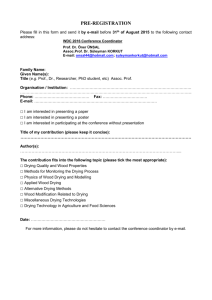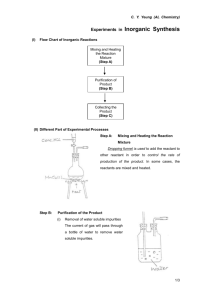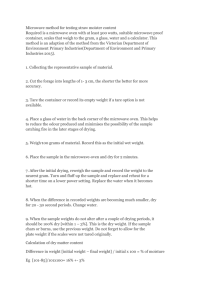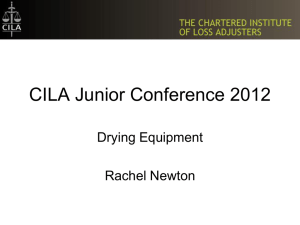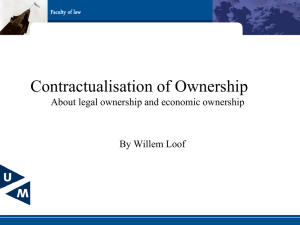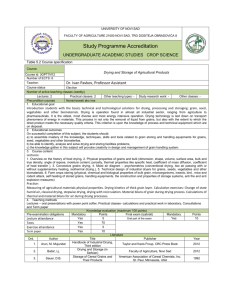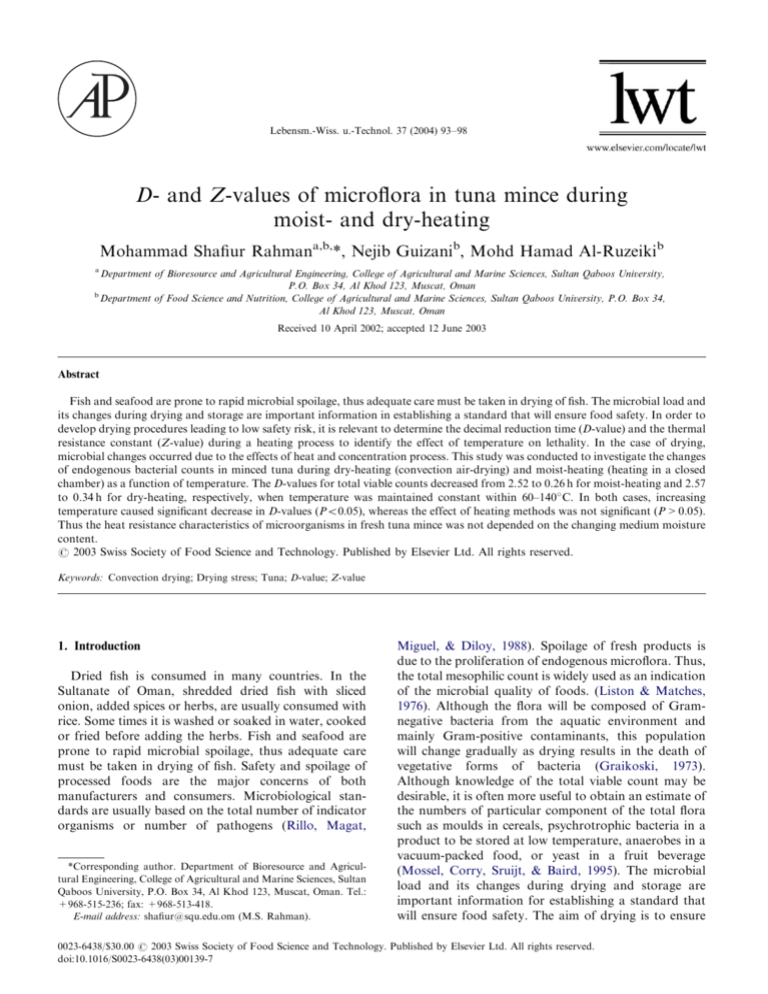
ARTICLE IN PRESS
Lebensm.-Wiss. u.-Technol. 37 (2004) 93–98
D- and Z-values of microflora in tuna mince during
moist- and dry-heating
Mohammad Shafiur Rahmana,b,*, Nejib Guizanib, Mohd Hamad Al-Ruzeikib
a
Department of Bioresource and Agricultural Engineering, College of Agricultural and Marine Sciences, Sultan Qaboos University,
P.O. Box 34, Al Khod 123, Muscat, Oman
b
Department of Food Science and Nutrition, College of Agricultural and Marine Sciences, Sultan Qaboos University, P.O. Box 34,
Al Khod 123, Muscat, Oman
Received 10 April 2002; accepted 12 June 2003
Abstract
Fish and seafood are prone to rapid microbial spoilage, thus adequate care must be taken in drying of fish. The microbial load and
its changes during drying and storage are important information in establishing a standard that will ensure food safety. In order to
develop drying procedures leading to low safety risk, it is relevant to determine the decimal reduction time (D-value) and the thermal
resistance constant (Z-value) during a heating process to identify the effect of temperature on lethality. In the case of drying,
microbial changes occurred due to the effects of heat and concentration process. This study was conducted to investigate the changes
of endogenous bacterial counts in minced tuna during dry-heating (convection air-drying) and moist-heating (heating in a closed
chamber) as a function of temperature. The D-values for total viable counts decreased from 2.52 to 0.26 h for moist-heating and 2.57
to 0.34 h for dry-heating, respectively, when temperature was maintained constant within 60–140 C. In both cases, increasing
temperature caused significant decrease in D-values (Po0:05), whereas the effect of heating methods was not significant (P > 0:05).
Thus the heat resistance characteristics of microorganisms in fresh tuna mince was not depended on the changing medium moisture
content.
r 2003 Swiss Society of Food Science and Technology. Published by Elsevier Ltd. All rights reserved.
Keywords: Convection drying; Drying stress; Tuna; D-value; Z-value
1. Introduction
Dried fish is consumed in many countries. In the
Sultanate of Oman, shredded dried fish with sliced
onion, added spices or herbs, are usually consumed with
rice. Some times it is washed or soaked in water, cooked
or fried before adding the herbs. Fish and seafood are
prone to rapid microbial spoilage, thus adequate care
must be taken in drying of fish. Safety and spoilage of
processed foods are the major concerns of both
manufacturers and consumers. Microbiological standards are usually based on the total number of indicator
organisms or number of pathogens (Rillo, Magat,
*Corresponding author. Department of Bioresource and Agricultural Engineering, College of Agricultural and Marine Sciences, Sultan
Qaboos University, P.O. Box 34, Al Khod 123, Muscat, Oman. Tel.:
+968-515-236; fax: +968-513-418.
E-mail address: shafiur@squ.edu.om (M.S. Rahman).
Miguel, & Diloy, 1988). Spoilage of fresh products is
due to the proliferation of endogenous microflora. Thus,
the total mesophilic count is widely used as an indication
of the microbial quality of foods. (Liston & Matches,
1976). Although the flora will be composed of Gramnegative bacteria from the aquatic environment and
mainly Gram-positive contaminants, this population
will change gradually as drying results in the death of
vegetative forms of bacteria (Graikoski, 1973).
Although knowledge of the total viable count may be
desirable, it is often more useful to obtain an estimate of
the numbers of particular component of the total flora
such as moulds in cereals, psychrotrophic bacteria in a
product to be stored at low temperature, anaerobes in a
vacuum-packed food, or yeast in a fruit beverage
(Mossel, Corry, Sruijt, & Baird, 1995). The microbial
load and its changes during drying and storage are
important information for establishing a standard that
will ensure food safety. The aim of drying is to ensure
0023-6438/$30.00 r 2003 Swiss Society of Food Science and Technology. Published by Elsevier Ltd. All rights reserved.
doi:10.1016/S0023-6438(03)00139-7
ARTICLE IN PRESS
94
M.S. Rahman et al. / Lebensm.-Wiss. u.-Technol. 37 (2004) 93–98
that the number of microorganisms that survive is
reduced to an acceptable level that delays spoilage of the
product and probably enhance its safety. To establish
the reduction in the number of microorganisms required
to achieve this consideration must be given to the initial
number of microorganisms of food. Drying also reduces
the water activity, thus preserving foods by avoiding microbial growth and chemical reactions causing
deterioration. In case of drying (dry-heating) and
cooking (moist-heating), microbial lethality needs to
be determined by estimating total destruction value
(F0 -value). Destruction of microorganisms by heat is
one of the hurdles in drying and cooking. In estimating
F0 -value for specific processing conditions, it is important to know the D- and Z-values. D-value, the
decimal reduction time (h), indicates the time required
to kill 90% of bacterial population at a specific
temperature. Z-value, the thermal resistance constant
( C), measures the temperature increase required to
cause a 90% reduction in the decimal reduction time.
These two values offer the basis for calculating process
times in food industry. Very limited work has been
reported on the effect of drying on the endogenous
microorganisms (pathogens and spoiling microflora)
present on foods. In the literature, D-values of the
endogenous spoilage flora were reported for orange juice
(Kopelman & Schyer, 1976), for grape juice (Soffer &
Mannheim, 1996) and minced tuna (Rahman, Guizani,
Al-Ruzeiki, & Al-Khalasi, 2000) as a function of
temperature.
Waliuzzaman, Fletcher, Rahman, and Perera (1999)
identified that further research needs to be carried out
for a wide variety of highly perishable food products.
Rahman et al. (2000) studied the changes of microflora
in tuna mince during convection air-drying. They found
that microorganisms grow in tuna during drying at low
temperatures. The drying temperature of 50 C or below
is not lethal to the microflora. The decimal reduction
time (D-value) of endogenous flora was determined
when drying temperatures were maintained constant
within the temperature range of 60–100 C.
The thermal death kinetics (D- and Z-values) may be
measured for single specific strains of microorganisms,
usually those of highest heat resistance present in a
particular food, or occasionally, for the whole natural
microbial population associated with that food. It is
important to note that that whole foodstuffs are most
likely to be heterogeneous and the microbial environment may vary locally with the food in terms of pH,
water activity, redox potential and concentration of
protein, carbohydrate and fat. Microbial standards for
production and distribution of foods are usually based
on the total viable counts, the number of indicator
organisms or the number of pathogens (Rillo et al.,
1988). In the present work, the main focus has been on
total viable counts in dried minced tuna. This approach
does not solve the problems related to spoilage and
safety of this product, but is a contribution to
development of specifications for reducing risk.
The objective of this study was to investigate the
changes of total bacterial counts in minced tuna during
convection air-drying at different temperatures for
moist- and dry-heating. The purpose was to identify
whether drying produces an extra effect on the microbial
death.
2. Materials and methods
Whole fresh tuna (Thunnus tongol) (local name,
Sahwa) was purchased from the local fish market
(Muscat) in the month of May. The mass and length
of the whole fish were about 3 kg and 0.45 m,
respectively. The fish was washed in tap water and then
filleted. The fillets were minced and frozen in blocks
(20 cm 13 cm 1.7 cm). The blocks were stored at
40 C, thawed at 20 C for 18 h prior to drying in
convection dryer. Samples were placed in a closed metal
chamber for moist-heating, and samples for dry-heating
were placed on a wire mesh tray. The dryer was set at a
constant temperature for each experiment. The temperature of drying air was maintained constant in an
experimental run within 60–140 C. Samples in closed
chamber and on the mesh tray were placed in the drier.
Samples were taken out from the drier at different time
intervals for the determination of water content and
microbial count. The water content and total solids were
measured gravimetrically by drying samples (5 replicates) in convection air drier at 105 C for at least 18 h.
Protein, fat, and ash were measured according to AOAC
(1990). All the compositions were expressed on wet basis
(kg/100 kg sample).
Microbial studies were carried out for each temperature tested by taking representative fish samples at
regular sampling times of the drying process. Fish
samples (5 g) in duplicate were aseptically removed from
dried fish and were homogenized in 45 ml of sterile
peptone water (0.1 g peptone in 100 ml water) (Oxoid,
Basingstoke, Hampshire, UK) in a stomacher Lab
blender 400 (Seward Medical, UK). Serial dilutions of
the fish homogenates were prepared using the same
solution. Each dilution (1 ml) was dispensed and poured
in duplicate with standard plate count agar for total
viable counts (CM 463, Oxoid, Basingstone, Hampshire,
UK) using aerobic incubation at 32 C for 48 h (FDA,
1992). Results are expressed as cfu/g of fish actual
weight. The osmo-tolerant microbes were determined by
adding 0.5 g (N1 ), 3.0 g (N2 ), and 5.0 g (N3 ) sodium
chloride in 100 ml agar when incubation temperature
and time was same as above. The Gram-negative
microbes were identified by growing sample in Maconkey broth at 32 C (N4 ). The thermo-tolerant microbes
ARTICLE IN PRESS
M.S. Rahman et al. / Lebensm.-Wiss. u.-Technol. 37 (2004) 93–98
1.00E+10
1.00E+08
1.00E+06
cfu/g
were determined by growing the sample in the agar plate
when incubation temperature was at 60 C (N5 ).
Statistical analysis (analysis of covariance) was done
using SAS to find the effect of heating method and
drying temperature on the changes of microflora in tuna
mince at 5% significance level (SAS, 1996).
95
1.00E+04
1.00E+02
3. Results and discussion
The proximate compositions of fresh tuna meat are
given in Table 1. The moisture content of fresh tuna was
70.50 kg per 100 kg sample. Total plate count of fresh
tuna meat before mincing and frozen storage was
7.3 106 cfu/gm. This number is considered high and
is however representative to fish delivered to the
consumer or to the food processing plants. It is the
result of the temperature abuse during transport at
room temperature.
1.00E+00
0.00
5.00
10.00
15.00
20.00
Time (hr)
Fig. 1. Plot of log NT versus moist-heating time at drying temperature
60 C.
1.0E+10
1.0E+08
The isothermal condition with constant moisture
content is not possible to maintain during drying since
the level of water content decreases with the progress of
drying.
The destruction of total aerobic flora was analysed
based on the estimation of the decimal reduction time
proposed by Bayrock and Ingledew (1997a). The
decimal reduction time or D-value (time required to
reduce the number by 1-log cycle) was obtained from the
slope of log10 NT versus time. The slope was estimated
only for the initial linear portion of the plot as used by
Rahman et al. (2000). Typical plots of log10 NT versus
time are shown in Figs. 1 and 2 for the moist- and dryheating conditions, respectively. These plots showed a
linear portion. D-values were estimated from the slope
of the logarithmic survivor versus drying time regression
data for the initial portion. The values of D are given in
Table 2 at different temperatures. The decimal reduction
time (D-value) varied from 2.52 to 0.26 h and 2.57 to
Table 1
Chemical composition of long tail tuna
Run no.
Proximate composition (kg/100 kg sample)
Water
Protein
Fat
Ash
1
2
3
4
5
6
71.55
70.04
70.32
70.32
70.04
70.75
24.13
24.20
23.23
24.48
24.39
24.32
2.09
3.30
1.97
2.06
2.82
2.00
1.38
1.44
1.45
1.45
1.47
1.47
Average
70.50 (0.57)
24.12 (0.46)
2.37 (0.55)
1.44 (0.03)
Note: Values in the parentheses are the standard deviation.
cfu/g
3.1. Effect of drying method on D-value
1.0E+06
1.0E+04
1.0E+02
1.0E+00
0.00
5.00
10.00
15.00
20.00
Time (hr)
Fig. 2. Plot of log NT versus dry-heating time at drying temperature
60 C.
Table 2
Initial D-value as a function of processing temperature for moist- and
dry-heating
T (oC)
60
70
80
90
100
120
140
D-value (h)
Moist-heating
Dry-heating
2.52
2.06
2.02
1.72
1.65
0.71
0.26
2.57
2.12
2.62
2.12
1.85
0.84
0.34
(0.71)
(0.27)
(0.44)
(0.16)
(0.30)
(0.19)
(0.25)
(0.28)
Note: Values in the parentheses are the standard deviation of six
replicates. Other values are the average of replicates.
0.34 h for moist- and dry-heating respectively, when
drying temperature was maintained constant within 60–
140 C. In this study, temperatures above 60 C were
considered since temperature below 60 C is not lethal to
the microflora as identified by Rahman et al. (2000).
ARTICLE IN PRESS
M.S. Rahman et al. / Lebensm.-Wiss. u.-Technol. 37 (2004) 93–98
96
These authors found that the D-values were 12.66 and
2.63 h at 60 C and 100 C, respectively. These values are
significantly different from values found by Rahman
et al. (2000). This variation indicates that D-values may
vary for the same food depending on the source and
harvesting time of the raw material. As expected the
values found in the present study decreased with the
increase of temperature, which indicated that increasing
temperature increased the lethal effect. In both cases,
increasing temperature caused significant decrease in Dvalues (Po0:05), whereas the effect of heating methods
was not significant (P > 0:05). Similarly Kim and
Bhowmik (1990) found that air temperature was a
major parameter affecting the death of lactic acid
bacteria during spray drying. Bayrock and Ingledew
(1997b) measured the D-values for the changing
moisture content (i.e. drying) and for moist conditions
(i.e. no change of moisture during heating). They
estimated the D-values from the slope of log10 NT versus
time of drying and found that D-values for drying
condition were much higher than the values from the
moist heat. This indicated that heat resistance of
microorganism increased significantly during drying
compared to the moist heat conditions. This finding is
in contradiction with our results, where the method of
drying has no significant influence on D-values.
another for high temperatures. The Z-values were found
144 C and 46 C for the temperature range 60–100 C,
and 100–140 C, respectively. This indicated that inactivation mechanisms varied at low and high temperature regions. At higher temperature flashing of moisture
could damage the cell further. The break of the slope
was at around 100 C. The break point observed in this
study could be attributed to the destruction of vegetative
cells rather than for spores. Vegetative cells are more
sensitive to heat when the cell water evaporates while
spores are not. This supports our view that D- and Zvalues should not used to guarantee the food safety, as
sporulating pathogens, if present, will not be destroyed
during the studied drying temperatures. Similar to this,
two linear portions were observed by Elizondo and
Labuza (1974) and suggested the danger in extrapolating
death kinetics to high temperature. They observed the
break at 84 C, which is lower than the value found in
this study. In case of spray drying of yeast similar order
of magnitude was also observed by Elizondo and
Labuza (1974) for Z-values. In case of Bacillus subtilis
spores, Molin (1977) found a linear portion within the
drying temperatures from 37 C to 190 C, whereas in
case of B. stearothermophilus spores they found two
linear portions in the plot of log D versus T plot.
3.3. Effect of moisture content change
3.2. Effect of temperature
The values of log D are plotted in Fig. 3 against
temperature to estimate the Z-value. The Z-value is
defined as the change of temperature required for 1-log
cycle change in D-values. The D-values below 90 C were
found to be similar (Table 2). It could be concluded that
increasing the temperature from 60 C to 90 C has
limited effect on the lethality of microbes, and other
criteria (vitamin degradation, maintenance of sensory
quality, technical convenience, etc.) could be used to
select drying temperature in this area. Fig. 3 showed two
linear portions, one for the low temperatures and
10
Wet-Heating
D (hr)
Dry-Heating
1
0.1
50
75
100
125
Temperature (°C)
Fig. 3. Plot of log D versus temperature.
150
In canning it is usual to estimate D-value at a specified
temperature (isothermal conditions) by maintaining
other parameters (such as moisture content) constant.
This ideal situation cannot be simulated in the destruction process of microflora during drying. This is due to
the change of moisture in the sample during drying
process, thus destruction is caused by a combination of
temperature and concentration process due to water
loss. In addition, the sample temperature during drying
is not easy to maintain at constant level since the sample
temperature during drying is always lower than the air
temperature due to cooling effect of evaporation. In the
case of tuna, change in moisture content during drying
showed no significant effect when compared with heating
with no moisture loss. In our study all other factors such
as pH, additives remained the same in both treatments.
The microbial deactivation kinetics is dependent upon
several factors: variety, water content (i.e. water
activity), temperature, and composition of a medium
(acidity, types of solids, pH, etc.) as well as heating
methods (Schaffner & Labuza, 1997; Juneja & Marmer,
1998; Lopez, Martinez, Gonzalez, Martin, & Bernado,
1998). In many studies during isothermal heating, it has
been demonstrated that D-value decreased (i.e. heat
sensitivity increased) as water content (i.e. water
activity) increased (Doyle & Marth, 1975; Schelhorn,
1973; Kim et al, 1997; Lopez et al., 1997; Lopez et al.,
1998). Opposite results were also observed in the case of
ARTICLE IN PRESS
M.S. Rahman et al. / Lebensm.-Wiss. u.-Technol. 37 (2004) 93–98
spores (Lopez et al., 1997). D-values increased with the
increase of water content. For example, D-value
increased 4.5 times when heat treatment was conducted
at water activity, adjusted by glycerol, of 0.99 (high
water content) compared to water activity 0.88. Also
specific effects of the solute types appeared to influence
D-values. Glycerol increased the heat sensitivity compared to sodium chloride and sucrose. Lopez et al.
(1998) found that solutes of benzoate and potassium
sorbate acted as inhibitory while they did not have
difference on D-values at pH 5.0, 6.0, and 6.5. In case of
Clostridium perfringens, D-values decreased (not inhibitory) when sodium pyrophosphate was added into
ground beef and turkey meat (Juneja & Marmer,
1998). Models to predict the D-values were also
developed as a function of temperature, pH, and water
activity for isothermal conditions (Cerf, Davey, &
Sadoudi, 1996; Blank, Yang, & Scanlon, 1998; Gaillard,
Leguerinel, & Mafart, 1998a b). The purpose of this
discussion is to present the complexity of the process
even for isothermal condition. It becomes more complicated during drying when both sample temperature and
water content varies with time.
3.4. Composition of the indigenous flora
It is important to identify the types and characteristics
of the endogenous microbes present in fresh tuna. The
microbial analysis of food products yields many diverse
types of microorganisms. However, we are more
concerned with the predominant types and those which
may cause spoilage or be of a health hazard (Banwart,
1989). Heat resistance is also dependent on the
composition of the endogenous microflora (Mossel
et al., 1995). Initially tuna contained a mixture of
different microbes, of which some are more heat and/or
osmo-tolerant than other. Gram-positive are often more
sensitive than Gram-negatives. Table 3 shows the types
of microflora present in the fresh tuna before drying.
This shows that most of the microflora present was the
osmo-tolerant since at zero time the Gram-negative (N4 )
Table 3
Types of microbes in fresh and dried tuna mince
Drying
time (h)
0
1
2
4
N2
(cfu/g)
N1
(cfu/g)
5
6.2 10
9.6 104
1.9 104
1.5 104
N3
(cfu/g)
6
1.5 10
9.8 104
3.5 103
2.9 103
1.5 10
n
n
n
and heat-tolerant (N5 ) microbes were 3 orders magnitude lower than N1 (Table 3). Moreover, addition of salt
in the agar can increase the count up to 2 order of
magnitude indicating that several of the bacteria in the
tuna require salt to grow, and are therefore not detected
on the plate count agar that is used for determination of
cfu. This result illustrates that the D- and Z-values
estimated in this work is related to aerobic counts
obtained on standard PCA, not to the total culture. The
salt requiring bacteria were most sensitive to drying
(Table 3, N2 and N3 ) and therefore would not affect the
measured D- and Z-values. A D-value of salt requiring
bacteria would be lower. It is expected that the type of
surviving microbes seems to stabilize after some time of
starting the drying. Further experiments were conducted
to explore more on this aspect by determining the types
of microbes count during drying. It shows that the
predominant microbes were the moderate-osmo-tolerant
since no microbes were detected when the salt concentration was 5% (N4 ), and the agar plate was incubated
at 60 C (N5 ) (Table 3). The evidence of no microbial
growth when incubated at 60 C indicated that the
dominating microbes grow during drying was heat
sensitive. This preliminary study indicates some characteristics of the type of microflora in the fresh and dried
tuna mice. More details studies need to be targeted in
the future.
4. Conclusion
The change of total viable counts in minced tuna
during moist- and dry-heating as a function of
temperature (60–140 C) was studied by estimating their
D- and Z-values. The D-values decreased from 2.52 to
0.26 h for moist-heating, and 2.57 to 0.34 h for dryheating, respectively. In both cases, increasing temperature caused significant decrease in D-values, whereas the
effect of heating methods was not significant on the
lethality of endogenous microflora. The Z-values were
found 144 C and 46 C for temperature within 60–
100 C, and 100–140 C, respectively.
Acknowledgements
N4
(cfu/g)
7
97
N5
(cfu/g)
2
2.4 10
2.0 102
1.5 102
5.5 101
2
1.0 10
n
n
n
Note: Drying temperature was 70 C, n indicates not detected, N1 is the
count at 0.5 g sodium chloride in 100 ml agar, N2 is the count at 3 g
sodium chloride in100 ml agar, N3 is the count at 5 g sodium chloride
in 100 ml agar, N4 is the gram-negative microbes as measured on
Maconky agar, N5 is the heat tolerant microbes.
The project was supported by the Sultan Qaboos
University internal grant IG/AGR/FOOD/00/02.
References
AOAC (1990). In: K. Helrich (Ed.), Official methods of analysis of the
AOAC. Arlington: Association of Official Analytical Chemists.
Banwart, D. J. (1989). Basic food microbiology (pp. 49–100).
New York: Chapman & Hall.
ARTICLE IN PRESS
98
M.S. Rahman et al. / Lebensm.-Wiss. u.-Technol. 37 (2004) 93–98
Bayrock, D., & Ingledew, W. M. (1997a). Fluidized bed drying of
baker’s yeast: Moisture levels, drying rates, and viability changes
during drying. Food Research International, 30(6), 407–415.
Bayrock, D., & Ingledew, W. M. (1997b). Mechanism of viability loss
during fluidized bed drying of baker’s yeast. Food Research
International, 30(6), 417–425.
Blank, G., Yang, R., & Scanlon, M. G. (1998). Influence of
sporulation aw on heat resistance and germination of Penicillium
roqueforti spores. Food Microbiology, 15, 151–156.
Cerf, O., Davey, K. R., & Sadoudi, A. K. (1996). Thermal inactivation
of bacteria—a new predictive model for the combined effect of
three environmental factors: Temperature, pH and water activity.
Food Research International, 29(3/4), 219–226.
Doyle, M. P., & Marth, E. H. (1975). Thermal inactivation of conidia
from Aspergillus flavus and Aspergillus parasiticus. I. Effects of
moist heat, age of conidia and sporulation medium. Journal of Milk
and Food Technology, 38, 678–682.
Elizondo, H., & Labuza, T. P. (1974). Death kinetics of yeast in spray
drying. Biotechnology and Bioengineering, 16, 1245–1259.
FDA (1992). Aerobic plate count. Food and drug administration
bacteriological analytical manual (7th ed.) (pp. 17–26). Arlington,
VA: FDA.
Gaillard, S., Leguerinel, I., & Mafart, P. (1998a). Model for combined
effects of temperature, pH and water activity on thermal
inactivation of Bacillus Cereus spores. Journal of Food Science,
63(5), 887–889.
Gaillard, S., Leguerinel, I., & Mafart, P. (1998b). Modelling combined
effects of temperature and pH on the heat resistance of spores of
Bacillus cereus. Food Microbiology, 15, 625–630.
Graikoski, J. T. (1973). Microbiology of cured and fermented fish:
Microbial safety of fisheries products (pp. 249–255). New York:
Academic Press.
Juneja, V. K., & Marmer, B. S. (1998). Thermal inactivation of
Clostridium Perfrigens vegetative cells in ground beef and Turkey
as affected by sodium pyrophosphaste. Food Microbiology, 15,
281–287.
Kim, S. S., & Bhowmik, S. R. (1990). Survival of lactic acid bacteria
during spray drying of plain yogurt. Journal of Food Science, 55(4),
108–110.
Kim, S. S, Shin, S. G., Chang, K. S., Kim, S. Y., Noh, B. S., &
Bhowmik, S. R. (1997). Survival of lactic acid bacteria during
microwave vacuum-drying of plain yogurt. Food Science and
Technology, 30, 573–577.
Kopelman, I. J., & Schyer, M. (1976). Thermal resistance of
endogenous flora in reconstituted orange juice. LebensmittelWissenschaft und Technologie, 9, 91–92.
Liston, J., & Matches, J. R. (1976). Fish crustaceans and precooked
seafoods. In: Speck, M. L. (Ed.), Compendium of methods for the
microbiological examination of foods (pp. 507–521). Washington,
DC: American Public Health Association.
Lopez, M., Gonzalez, I., Mazas, M., Gonzalez, J., Martin, &
Bernardo, R. (1997). A influence of recovery conditions on
apparent heat resistance of Bacillus stearothermophilus spores.
International Journal of Food Science and Technology, 32, 305–311.
Lopez, M., Martinez, S., Gonzalez, J., Martin, R., & Bernado, A.
(1998). Sensitization of thermally injured spores of Bacillus
Stearothermophilus to sodium benzoate and potassium sorbate.
Letters in Applied Microbiology, 27, 331–335.
Molin, G. (1977). Inactivation of bacillus spores in dry systems at low
and high temperatures. Journal of General Microbiology, 101(2),
227–231.
Mossel, D. A. A., Corry, J. E. L., Sruijt, C. B., & Baird, R. M. (1995).
Essentials of the microbiology of foods (pp. 63–109). New York: Wiley.
Rahman, M. S., Guizani, N., Al-Ruzeiki, M. H., & Al-Khalasi, S.
(2000). Microflora changes in tuna during convection air drying.
Drying Technology, 18(10), 2369–2379.
Rillo, B. O., Magat, R. P., Miguel, M. M. S., & Diloy, M. L. (1988).
Microbiological quality of dried salted mackeral (Rastrelliger
brachyosomus). In S. Mannepun, P. Varangoon, & B. Phithakpol
(Eds.), Food science and technology in Industrial development
(pp. 690–694). Bangkok: Institute of Food Research and product
Development.
SAS (1996). SAS users’ guide: Statistics. NC: SAS Institute.
Schaffner, D. W., & Labuza, T. P. (1997). Predictive microbiology:
Where are we, and where are we going. Food Technology, 51(4),
95–99.
Schelhorn, M. L. (1973). Influence of relative humidity conditions on
the thermal resistance of several kinds of spores of molds. Acta
Alimentaria, 2, 163–171.
Soffer, T., & Mannheim, C. H. (1996). Effect of minimal heat
treatment and carbon dioxide on shelf life of grapefruit juice. Fruit
Processing, 3, 99–101.
Waliuzzaman, Z., Fletcher, G., Rahman, M. S., & Perera, C. O.
(1999). The microflora changes in fish mince during heat pump
dehumidifier drying. Proceedings of the 10th world congress of food
science and technology, Sydney.

